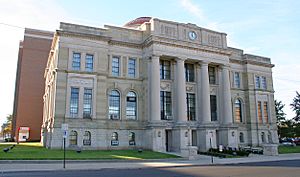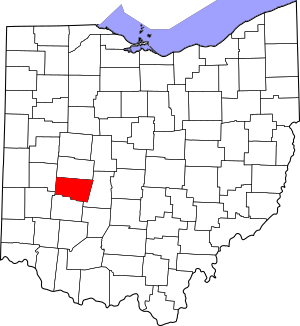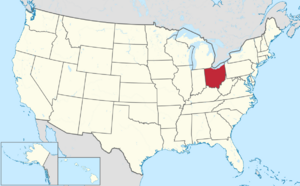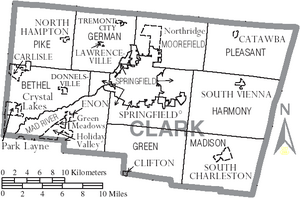Clark County, Ohio facts for kids
Quick facts for kids
Clark County
|
|||
|---|---|---|---|

|
|||
|
|||

Location within the U.S. state of Ohio
|
|||
 Ohio's location within the U.S. |
|||
| Country | |||
| State | |||
| Founded | March 1, 1818 | ||
| Named for | George Rogers Clark | ||
| Seat | Springfield | ||
| Largest city | Springfield | ||
| Area | |||
| • Total | 403 sq mi (1,040 km2) | ||
| • Land | 397 sq mi (1,030 km2) | ||
| • Water | 5.1 sq mi (13 km2) 1.3%% | ||
| Population
(2020)
|
|||
| • Total | 136,001 | ||
| • Estimate
(2023)
|
134,610 |
||
| • Density | 337.5/sq mi (130.30/km2) | ||
| Time zone | UTC−5 (Eastern) | ||
| • Summer (DST) | UTC−4 (EDT) | ||
| Congressional districts | 10th, 15th | ||
Clark County is a county in the west-central part of Ohio. It is like a special region within the state. In 2020, about 136,000 people lived here.
The biggest city and the main center for the county's government is Springfield. Clark County was started on March 1, 1818. It was named after General George Rogers Clark. He was a brave hero from the American Revolution, a war that helped America become independent.
Contents
Exploring Clark County's Geography
Clark County covers about 403 square miles. Most of this area, about 397 square miles, is land. The rest, about 5.1 square miles, is water. This makes it one of the smaller counties in Ohio.
Neighboring Counties
Clark County shares its borders with several other counties:
- Champaign County (to the north)
- Madison County (to the east)
- Greene County (to the south)
- Montgomery County (to the southwest)
- Miami County (to the west)
People and Population in Clark County
The number of people living in Clark County has changed over many years. You can see how the population has grown and shifted below.
| Historical population | |||
|---|---|---|---|
| Census | Pop. | %± | |
| 1820 | 9,533 | — | |
| 1830 | 13,114 | 37.6% | |
| 1840 | 16,882 | 28.7% | |
| 1850 | 22,178 | 31.4% | |
| 1860 | 25,300 | 14.1% | |
| 1870 | 32,070 | 26.8% | |
| 1880 | 41,948 | 30.8% | |
| 1890 | 52,277 | 24.6% | |
| 1900 | 58,939 | 12.7% | |
| 1910 | 66,435 | 12.7% | |
| 1920 | 80,728 | 21.5% | |
| 1930 | 90,936 | 12.6% | |
| 1940 | 95,647 | 5.2% | |
| 1950 | 111,661 | 16.7% | |
| 1960 | 131,440 | 17.7% | |
| 1970 | 157,115 | 19.5% | |
| 1980 | 150,236 | −4.4% | |
| 1990 | 147,548 | −1.8% | |
| 2000 | 144,742 | −1.9% | |
| 2010 | 138,333 | −4.4% | |
| 2020 | 136,001 | −1.7% | |
| 2023 (est.) | 134,610 | −2.7% | |
| U.S. Decennial Census 1790-1960 1900-1990 1990-2000 2020 |
|||
Clark County's Population in 2020
In 2020, there were 136,001 people living in Clark County. There were 54,862 households, which are groups of people living together. The average household had about 2.39 people.
The median age in the county was 41.5 years old. This means half the people were younger and half were older. About 22.5% of the residents were under 18 years old. Also, 19.4% were 65 years or older.
Most people in the county, about 88.9% of those over 25, had finished high school. About 18.9% of people over 25 had earned a bachelor's degree from college.
Learning and Education in Clark County
Clark County has many schools and colleges. They help students learn and grow.
Public School Districts
Here are some of the public school districts in the county:
- Cedar Cliff Local School District
- Clark - Shawnee Local School District
- Shawnee High School, Springfield (the Braves)
- Greenon Local School District
- Greenon High School, Springfield (the Knights)
- Fairborn City School District
- Northeastern Local School District
- Kenton Ridge High School, Springfield (the Cougars)
- Northeastern High School, Springfield (the Jets)
- Northwestern Local School District
- Northwestern High School, Springfield (the Warriors)
- Southeastern Local Schools
- Southeastern High School, South Charleston (the Trojans)
- Springfield City School District
- Springfield High School, (the Wildcats)
- Tecumseh Local School District
- Tecumseh High School, New Carlisle (the Arrows)
- Yellow Springs Exempted Village School District
Colleges and Universities
Students can also go to college right in Clark County:
- Clark State College, Springfield (the Eagles)
- Wittenberg University, Springfield (the Tigers)
Cities and Towns in Clark County
Clark County has different types of communities. These include cities, villages, and townships.
Cities
- New Carlisle
- Springfield (This is the county seat, where the main county government offices are.)
Villages
Townships
- Bethel
- German
- Green
- Harmony
- Mad River
- Madison
- Moorefield
- Pike
- Pleasant
- Springfield
Census-designated places
These are areas that are like towns but don't have their own local government.
Unincorporated communities
These are smaller places that are not part of a city or village.
See also
 In Spanish: Condado de Clark (Ohio) para niños
In Spanish: Condado de Clark (Ohio) para niños




